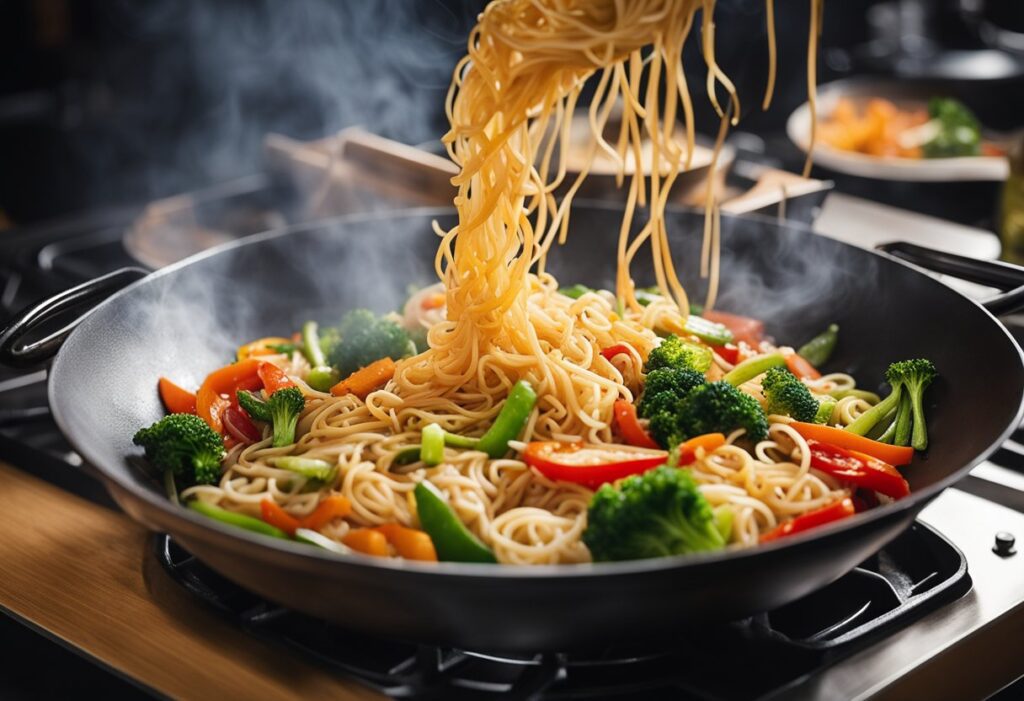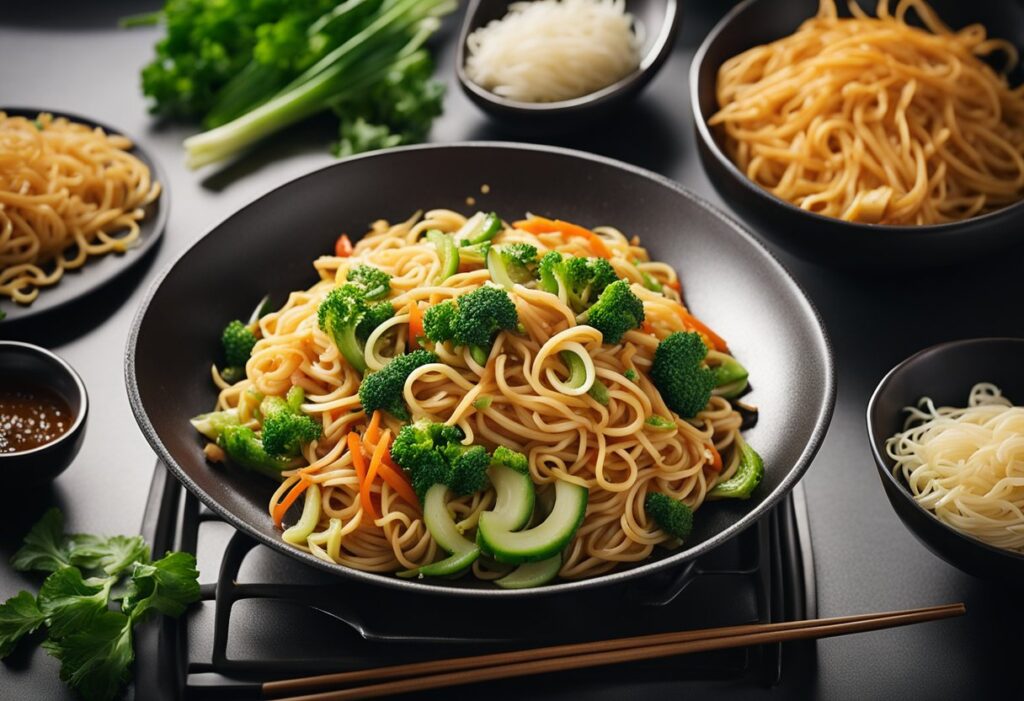Lo mein is a popular Chinese dish that has become a staple in many households. It is a versatile dish that can be made with a variety of ingredients, making it a go-to option for busy weeknights. Many people are intimidated by the thought of making lo mein at home, but with the right recipe and some basic cooking skills, it can be an easy and delicious meal to prepare.
One of the best things about making lo mein at home is that you can customize it to your liking. You can use your favorite vegetables, proteins, and sauces to create a dish that is tailored to your taste buds. Plus, making it at home means you can control the amount of sodium and other additives that are often found in restaurant versions.
If you’re looking for an easy lo mein recipe that you can make at home, look no further. With just a few simple ingredients and some basic cooking techniques, you can have a delicious and satisfying meal on the table in no time. Whether you’re a beginner cook or an experienced chef, this lo mein recipe is sure to become a favorite in your household.
Essential Ingredients
When it comes to making a delicious and easy lo mein recipe, there are a few essential ingredients that should not be overlooked. These ingredients are the building blocks of any good lo mein dish and can be customized to suit individual tastes and preferences.
Noodles
The first and most important ingredient in any lo mein recipe is the noodles. Typically, Chinese egg noodles are used for lo mein, but other types of noodles such as udon or soba can also be used. It is important to cook the noodles according to the package instructions and then rinse them with cold water to prevent them from sticking together.
Proteins
Proteins are an essential component of any lo mein recipe. Some popular protein options include chicken, beef, shrimp, and tofu. It is important to cut the protein into bite-sized pieces and cook them separately before adding them to the lo mein. This ensures that they are cooked evenly and do not overcook or undercook.
Vegetables
Vegetables are another important ingredient in any lo mein recipe. The vegetables can be customized to suit individual tastes and preferences, but some popular options include carrots, bell peppers, onions, and mushrooms. It is important to cut the vegetables into thin strips or small pieces to ensure that they cook evenly.
Sauces and Seasonings
The final essential ingredient in any lo mein recipe is the sauces and seasonings. Soy sauce, oyster sauce, and sesame oil are commonly used in lo mein dishes. Other seasonings such as garlic, ginger, and red pepper flakes can also be added to enhance the flavor. It is important to taste the dish as you go and adjust the seasonings as needed.
By using these essential ingredients and customizing them to suit individual tastes and preferences, anyone can create a delicious and easy lo mein recipe that is sure to impress.
Preparation Overview

Preparing a delicious and easy lo mein recipe can be done in just a few simple steps. Before starting, gather all the necessary ingredients and kitchen tools.
Noodle Cooking Instructions
The first step in preparing lo mein is to cook the noodles. Boil a pot of water and add the noodles. Cook them according to the package instructions, usually for about 3-5 minutes. Once they are cooked, drain them and rinse them with cold water to prevent them from sticking together.
Stir-Frying Techniques
Stir-frying is an important technique in preparing lo mein. Heat a wok or large skillet over high heat and add oil. Once the oil is hot, add the vegetables and stir-fry them for a few minutes until they are tender but still crisp. Then, add the protein and stir-fry until it is cooked through.
Combining Ingredients
Once the noodles, vegetables, and protein are all cooked, it’s time to combine them. Add the noodles to the wok or skillet and stir-fry everything together, adding the sauce as you go. Make sure to mix everything well so that the sauce is evenly distributed.
Overall, preparing an easy lo mein recipe is a straightforward process that anyone can do with a bit of practice. With these simple steps and techniques, you can create a delicious and satisfying meal in no time.
Cooking Steps

Preparing the Noodles
To start making lo mein, the first step is to prepare the noodles. Cook the noodles according to the package instructions. Once cooked, drain the water and rinse the noodles under cold water to prevent them from sticking together. Drizzle some sesame oil and toss the noodles to prevent them from drying out.
Cooking the Proteins
In a separate pan, cook the proteins such as chicken, beef, or shrimp. Cut the proteins into small bite-sized pieces and season them with salt and pepper. Heat some oil in the pan and add the proteins. Cook until they are browned and fully cooked through. Remove the proteins from the pan and set them aside.
Stir-Frying Vegetables
Next, stir-fry the vegetables. Cut the vegetables into thin slices or julienne them. Heat some oil in the pan and add the vegetables. Stir-fry until they are tender but still crisp. Add some garlic and ginger for flavor. Remove the vegetables from the pan and set them aside.
Mixing in the Sauce
The final step is to mix in the sauce. In a small bowl, mix together soy sauce, oyster sauce, hoisin sauce, and a pinch of sugar. Add the sauce to the pan and toss to coat the noodles and vegetables. Add the cooked proteins and toss again. Garnish with some chopped scallions and sesame seeds.
Lo mein is now ready to be served. Enjoy!
Serving Suggestions
Plating
When serving lo mein, it is important to remember that presentation is key. A well-plated dish can make all the difference in how enjoyable your meal is. To plate your lo mein, start by using a pair of tongs to separate the noodles. Then, place them in the center of a plate or bowl. It is best to use a deep dish to prevent the noodles from spilling over the sides.
Next, add your protein and vegetables on top of the noodles. Be sure to evenly distribute them to ensure that each bite has a balanced mix of flavors. If desired, you can also sprinkle sesame seeds or chopped scallions on top for added texture and flavor.
Garnishing
Garnishing is another important aspect of serving lo mein. It not only adds visual appeal but can also enhance the overall flavor of the dish. A simple garnish of chopped scallions or cilantro can add a burst of freshness to your lo mein.
Another popular garnish for lo mein is crispy fried noodles. These can be found in most grocery stores and are a great way to add crunch to your dish. Simply sprinkle them on top of your lo mein before serving.
Overall, plating and garnishing your lo mein can take your dish to the next level. With a little bit of creativity and attention to detail, you can create a restaurant-worthy meal in the comfort of your own home.
Variations
Vegetarian and Vegan Options
For those who prefer a meatless version of lo mein, there are plenty of options available. Instead of using meat, one can add vegetables such as broccoli, carrots, mushrooms, bell peppers, and snow peas to the dish. To add more flavor, one can also include tofu or tempeh. These protein alternatives can be marinated in soy sauce or other seasonings before adding them to the dish. For a vegan version, simply replace the egg noodles with rice noodles or other vegan-friendly noodles.
Protein Alternatives
For those who want to add some protein to their lo mein, there are several options available. Chicken, beef, shrimp, and pork are the most commonly used meats in lo mein. However, one can also use other meats such as duck, lamb, or even venison. To make the dish healthier, one can use lean cuts of meat or substitute with seafood such as fish or scallops. For a vegetarian option, one can use seitan or textured vegetable protein (TVP) as a meat substitute.
When it comes to making lo mein, the possibilities are endless. By experimenting with different vegetables and proteins, one can create a unique and flavorful dish every time.
Storing and Reheating
Once you have prepared your delicious lo mein dish, you may have leftovers that you want to save for later. Proper storage and reheating can help maintain the quality and flavor of your dish.
To store your lo mein, transfer it to an airtight container and refrigerate it promptly. It is best to consume within 3-4 days. If you need to store it for longer, you can freeze it for up to 2 months. To thaw frozen lo mein, transfer it to the refrigerator and let it thaw overnight.
When reheating your lo mein, there are a few things to keep in mind. If you are reheating in the microwave, cover the dish with a damp paper towel to prevent drying out. You can also reheat in a pan on the stove over low heat, adding a splash of water or broth to prevent sticking.
It is important to note that reheating lo mein may cause the noodles to become soft and mushy. To prevent this, consider reheating the sauce and vegetables separately and adding them to the noodles just before serving.
By following these simple tips, you can enjoy your homemade lo mein for days to come.
Common Mistakes to Avoid
When preparing lo mein, there are a few common mistakes that can easily be avoided to ensure a delicious outcome. Here are some tips to keep in mind:
- Overcooking the noodles: Overcooked noodles can become mushy and lose their texture. Follow the package instructions and cook the noodles until they are just tender. Rinse them with cold water to stop the cooking process and prevent them from sticking together.
- Using the wrong type of noodles: Lo mein noodles are typically made from wheat flour and eggs. Make sure to use the right type of noodles for the recipe to achieve the desired texture and flavor.
- Not seasoning the dish properly: Lo mein is a simple dish, but it still requires seasoning to bring out the flavors. Soy sauce, sesame oil, and garlic are common ingredients used to season lo mein. Be sure to taste the dish as you cook and adjust the seasoning as needed.
- Overcrowding the pan: When stir-frying the vegetables and noodles, make sure not to overcrowd the pan. This can cause the ingredients to steam rather than fry, resulting in a soggy dish. Cook the ingredients in batches if necessary.
- Adding too much sauce: While sauce is important for flavor, adding too much can make the dish overly salty or sweet. Start with a small amount of sauce and add more as needed.
By avoiding these common mistakes, you can easily make a delicious and satisfying lo mein dish at home.

